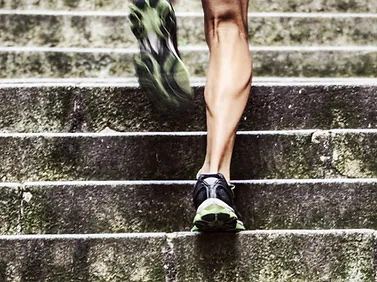Achilles Tendinopathy
(Tendinitis)
Injury Guide

Are you an athlete suffering from Achilles tendinopathy (tendinitis)? This condition can start out as a minor inconvenience, but can quickly progress to impede your performance and capacity for running and jumping significantly. Don’t let a tired Achilles tendon stop you from moving forward! At Latitude Physiotherapy, we specialize in helping athletes like you overcome Achilles tendinopathy and get back in the game stronger than ever. In this guide, we’ll explore the symptoms, causes, and effective rehab strategies for this annoying problem!
Symptoms:
Achilles tendinopathy is characterized by several common symptoms. Individuals may experience pain and stiffness along the Achilles tendon, just above the back of the heel bone, and it tends to be more pronounced during or after physical activity. Swelling and tenderness can also be present around the affected area. In some cases, individuals may notice morning stiffness or discomfort after sitting for long periods. The symptoms can gradually worsen over time, potentially leading to difficulty walking or running.
Anatomy:
The Achilles tendon, the largest and strongest tendon in the human body, plays a crucial role in transmitting the force generated by the calf muscles to the heel bone during movement. It is a thick, fibrous band of connective tissue composed primarily of type I collagen fibers, providing tensile strength and resilience. However, the Achilles tendon has a relatively poor blood supply, particularly in its mid-portion, making it more susceptible to injury and slower to heal compared to other tendons. Limited blood flow hinders the delivery of oxygen, nutrients, and immune cells necessary for optimal healing, contributing to the development of Achilles tendinopathy.
Surrounding the Achilles tendon, there are two protective layers: the outer paratenon and inner endotenon. The paratenon provides a lubricating function, allowing smooth gliding of the tendon during movement. Dysfunction or inflammation of the paratenon can contribute to the development of Achilles tendinopathy. Additionally, the Achilles tendon is highly adaptable and responds to mechanical stresses by adapting its structure. Excessive or repetitive loading can lead to biochemical and structural changes in the tendon, such as collagen disorganization, increased cellularity, and neovascularization. If the tendon is unable to adapt or repair itself adequately, these changes can result in degeneration and the development of Achilles tendinopathy.
Causes:
There are various factors that can contribute to the development of Achilles tendinopathy. One common cause is overuse, which involves repetitive stress and strain on the tendon from intense athletic activities, particularly those that involve jumping and running. Another cause is a sudden increase in activity level, such as rapidly ramping up the intensity, duration, or frequency of workouts without allowing adequate time for the tendon to adapt. Wearing worn out shoes can also lead to increased stress on the tendon. Additionally, biomechanical factors such as foot structure abnormalities, muscle imbalances, or faulty movement patterns can put excess strain on the tendon.
Rehab Strategies:
When it comes to rehabilitating Achilles tendinopathy in athletes, there are several effective strategies, but the most important step is to receive a thorough physical therapy exam. A trained physical therapist know how to best diagnose your movement dysfunction and create an individualized treatment plan just for you. Latitude Physiotherapy offers comprehensive assessments to identify the underlying causes and the severity of the condition. Should you require examination by another practitioner, we are trained to know when to refer out. Once we determine the root cause, we’ll design a personalized treatment plan that is tailored to your specific needs, goals, and athletic demands.
One common exercise technique used in rehab for Achilles strengthening is eccentrics. Heel drops, or eccentric calf raises, have been proven to stimulate healing and rehabilitate the Achilles tendon. Enter N2HZJPY8 at medbridgego.com to learn how to do eccentric calf raises. If performed correctly with the right dosage, many patients experience pain relief after performing them. Working with a manual physical therapist can ensure optimal performance of your exercises and help you progress with them safely to improve your tendon strength.
Manual therapy techniques are utilized to address muscle tightness, improve tissue flexibility, and enhance blood flow to the affected area. At Latitude Physiotherapy we employ hands-on techniques like soft tissue manipulation and massage, myofascial release, joint manipulation, dry needling, gua sha, and cupping to achieve these goals.
To address any underlying biomechanical issues, we provide a thorough analysis of the athlete’s movement patterns and biomechanics. Customized corrective exercises, devices, and footwear recommendations are provided as necessary to address any muscle imbalances and optimize movement mechanics.
Finally, it’s important for athletes to return to sport in a graduated manner. Latitude Physiotherapy can create a progressive plan to help reintegrate athletes safely into their sport or activity. By gradually increasing exercise intensity, monitoring symptoms, and making adjustments as needed, you can prevent re-injury and optimize athletic performance.
At Latitude Physiotherapy, we’re committed to helping athletes like you conquer Achilles tendinopathy and reach your full potential. Don’t let this condition hold you back any longer!
Let’s
Work
Together
Ready to get started? Click here. General questions? Read our FAQ page. Have a specific question? Leave us a message!
